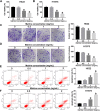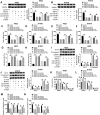Matrine Regulates Proliferation, Apoptosis, Cell Cycle, Migration, and Invasion of Non-Small Cell Lung Cancer Cells Through the circFUT8/miR-944/YES1 Axis
- PMID: 33907466
- PMCID: PMC8065209
- DOI: 10.2147/CMAR.S290966
Matrine Regulates Proliferation, Apoptosis, Cell Cycle, Migration, and Invasion of Non-Small Cell Lung Cancer Cells Through the circFUT8/miR-944/YES1 Axis
Retraction in
-
Matrine Regulates Proliferation, Apoptosis, Cell Cycle, Migration, and Invasion of Non-Small Cell Lung Cancer Cells Through the circFUT8/miR-944/YES1 Axis [Retraction].Cancer Manag Res. 2022 Dec 15;14:3455-3456. doi: 10.2147/CMAR.S401320. eCollection 2022. Cancer Manag Res. 2022. PMID: 36545224 Free PMC article.
Abstract
Background: Non-small cell lung carcinoma (NSCLC) is the major histological subtype of cancer cases. In the present study, we investigated the association between Matrine, an active component of Chinese medicine, and circFUT8 in NSCLC cells.
Methods: The proliferation ability of NSCLC cells was assessed by MTT and colony-forming assays. Flow cytometry assay was performed to show the apoptosis and cell cycle distribution in NSCLC cells. The protein expression levels of Bcl-2, Cleaved Caspase-3 (C-Caspase3), and YES proto-oncogene 1 (YES1) were measured by Western blot assay. Migration and invasion of NSCLC cells were determined by transwell assay. The expression levels of circFUT8, miR-944 and YES1 were quantified by real-time quantitative polymerase chain reaction (RT-qPCR) assay. The interaction relationship between miR-944 and circFUT8 or YES1 was confirmed by dual-luciferase reporter assay. The anti-tumor role of Matrine in vivo was explored by a xenograft experiment.
Results: Matrine functioned as a carcinoma inhibitor by repressing proliferation, cell cycle process, migration, and invasion while inducing apoptosis in NSCLC cells. Importantly, overexpression of circFUT8 counteracted Matrine-induced effects on NSCLC cells. MiR-944, interacted with YES1, was a target of circFUT8. Under Matrine condition, overexpression of circFUT8 increased proliferation, migration, and invasion while inhibited apoptosis, which was abolished by the upregulation of miR-944. Whereas the silencing of YES1 counteracted miR-944 inhibitor-induced effects on NSCLC cells. Eventually, we also confirmed that Matrine impeded NSCLC tumor growth in vivo.
Conclusion: Matrine regulated proliferation, apoptosis, cell cycle, migration, and invasion of NSCLC cells through the circFUT8/miR-944/YES1 axis, which provided novel information for Matrine in NSCLC.
Keywords: Matrine; NSCLC; YES1; circFUT8; miR-944.
© 2021 Zhu et al.
Conflict of interest statement
The authors declare that they have no financial or non-financial conflicts of interest for this work.
Figures









Similar articles
-
Matrine Regulates Proliferation, Apoptosis, Cell Cycle, Migration, and Invasion of Non-Small Cell Lung Cancer Cells Through the circFUT8/miR-944/YES1 Axis [Retraction].Cancer Manag Res. 2022 Dec 15;14:3455-3456. doi: 10.2147/CMAR.S401320. eCollection 2022. Cancer Manag Res. 2022. PMID: 36545224 Free PMC article.
-
MicroRNA-133a inhibits the proliferation of non-small cell lung cancer by targeting YES1.Oncol Lett. 2019 Dec;18(6):6759-6765. doi: 10.3892/ol.2019.11030. Epub 2019 Nov 1. Oncol Lett. 2019. PMID: 31807185 Free PMC article.
-
Effect of miR-140-5p on the regulation of proliferation and apoptosis in NSCLC and its underlying mechanism.Exp Ther Med. 2019 Aug;18(2):1350-1356. doi: 10.3892/etm.2019.7701. Epub 2019 Jun 21. Exp Ther Med. 2019. PMID: 31363375 Free PMC article.
-
Propofol suppresses non-small cell lung cancer tumorigenesis by regulation of circ-RHOT1/miR-326/FOXM1 axis.Life Sci. 2021 Jan 27:119042. doi: 10.1016/j.lfs.2021.119042. Online ahead of print. Life Sci. 2021. PMID: 33515563
-
Role of YES1 signaling in tumor therapy resistance.Cancer Innov. 2023 Mar 3;2(3):210-218. doi: 10.1002/cai2.51. eCollection 2023 Jun. Cancer Innov. 2023. PMID: 38089407 Free PMC article. Review.
Cited by
-
Novel Insights into miR-944 in Cancer.Cancers (Basel). 2022 Aug 31;14(17):4232. doi: 10.3390/cancers14174232. Cancers (Basel). 2022. PMID: 36077769 Free PMC article. Review.
-
Digital multiplexed analysis of circular RNAs in FFPE and fresh non-small cell lung cancer specimens.Mol Oncol. 2022 Jun;16(12):2367-2383. doi: 10.1002/1878-0261.13182. Epub 2022 Feb 10. Mol Oncol. 2022. PMID: 35060299 Free PMC article.
-
Combinatorial Blood Platelets-Derived circRNA and mRNA Signature for Early-Stage Lung Cancer Detection.Int J Mol Sci. 2023 Mar 2;24(5):4881. doi: 10.3390/ijms24054881. Int J Mol Sci. 2023. PMID: 36902312 Free PMC article.
-
Circular RNA circ_0003028 contributes to tumorigenesis by regulating GOT2 via miR-1298-5p in non-small cell lung cancer.Bioengineered. 2021 Dec;12(1):2326-2340. doi: 10.1080/21655979.2021.1935064. Bioengineered. 2021. PMID: 34077306 Free PMC article.
-
CRISPR/Cas9 application in cancer therapy: a pioneering genome editing tool.Cell Mol Biol Lett. 2022 May 4;27(1):35. doi: 10.1186/s11658-022-00336-6. Cell Mol Biol Lett. 2022. PMID: 35508982 Free PMC article. Review.
References
Publication types
LinkOut - more resources
Full Text Sources
Other Literature Sources
Research Materials

